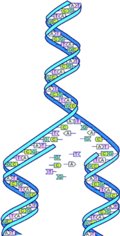Okazaki fragments
Okazaki fragments are short, newly synthesized DNA fragments that are formed on the lagging template strand during DNA replication. They are complementary to the lagging template strand, together forming short double-stranded DNA sections. Okazaki fragments are named after the Japanese scientist Reiji Okazaki, who first discovered them.
Discovery
Reiji Okazaki and his team of researchers at the University of Nagoya in Japan discovered Okazaki fragments in 1968. They were studying the mechanism of DNA replication in Escherichia coli, a type of bacteria. The discovery of Okazaki fragments provided crucial evidence supporting the theory that DNA replication is a discontinuous process on the lagging strand.
Structure and Formation
Okazaki fragments are typically between 1,000 to 2,000 nucleotides long in Eukaryotes, and approximately 100-200 nucleotides long in Prokaryotes. They are formed because the lagging strand that is being used as a template for replication has its 3' end facing away from the replication fork. This means that DNA polymerase, the enzyme that synthesizes new DNA, cannot add nucleotides in the direction of replication.
The formation of Okazaki fragments begins with the synthesis of a short RNA primer by the enzyme Primase. This primer serves as a starting point for DNA polymerase, which begins adding nucleotides, forming the Okazaki fragment. Once an Okazaki fragment has been synthesized, the RNA primer is removed and replaced with DNA by the enzyme DNA polymerase I in prokaryotes and Pol δ in eukaryotes. The fragments are then joined together by the enzyme DNA ligase to form a continuous DNA strand.
Role in DNA Replication
The discovery of Okazaki fragments confirmed that DNA replication is a discontinuous process on the lagging strand. This is because DNA polymerase can only synthesize DNA in a 5' to 3' direction, but the lagging strand is oriented in a 3' to 5' direction at the replication fork. Therefore, replication on the lagging strand occurs in short bursts, producing Okazaki fragments.
The formation of Okazaki fragments is a crucial step in DNA replication, as it allows the replication of the lagging strand to occur in the same overall direction as replication of the leading strand. This ensures that the entire DNA molecule is accurately and efficiently replicated.
See Also
Transform your life with W8MD's budget GLP-1 injections from $125.
W8MD offers a medical weight loss program to lose weight in Philadelphia. Our physician-supervised medical weight loss provides:
- Most insurances accepted or discounted self-pay rates. We will obtain insurance prior authorizations if needed.
- Generic GLP1 weight loss injections from $125 for the starting dose.
- Also offer prescription weight loss medications including Phentermine, Qsymia, Diethylpropion, Contrave etc.
NYC weight loss doctor appointments
Start your NYC weight loss journey today at our NYC medical weight loss and Philadelphia medical weight loss clinics.
- Call 718-946-5500 to lose weight in NYC or for medical weight loss in Philadelphia 215-676-2334.
- Tags:NYC medical weight loss, Philadelphia lose weight Zepbound NYC, Budget GLP1 weight loss injections, Wegovy Philadelphia, Wegovy NYC, Philadelphia medical weight loss, Brookly weight loss and Wegovy NYC
|
WikiMD's Wellness Encyclopedia |
| Let Food Be Thy Medicine Medicine Thy Food - Hippocrates |
Medical Disclaimer: WikiMD is not a substitute for professional medical advice. The information on WikiMD is provided as an information resource only, may be incorrect, outdated or misleading, and is not to be used or relied on for any diagnostic or treatment purposes. Please consult your health care provider before making any healthcare decisions or for guidance about a specific medical condition. WikiMD expressly disclaims responsibility, and shall have no liability, for any damages, loss, injury, or liability whatsoever suffered as a result of your reliance on the information contained in this site. By visiting this site you agree to the foregoing terms and conditions, which may from time to time be changed or supplemented by WikiMD. If you do not agree to the foregoing terms and conditions, you should not enter or use this site. See full disclaimer.
Credits:Most images are courtesy of Wikimedia commons, and templates, categories Wikipedia, licensed under CC BY SA or similar.
Contributors: Prab R. Tumpati, MD




